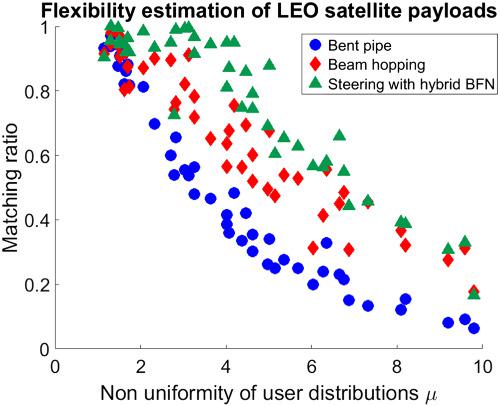当前位置:
X-MOL 学术
›
Int. J. Satell. Commun. Netw.
›
论文详情
Our official English website, www.x-mol.net, welcomes your
feedback! (Note: you will need to create a separate account there.)
A methodology to benchmark flexible payload architectures in a megaconstellation use case
International Journal of Satellite Communications and Networking ( IF 0.9 ) Pub Date : 2020-03-02 , DOI: 10.1002/sat.1344 Florian Vidal 1 , Hervé Legay 1 , George Goussetis 2 , Maria Garcia Vigueras 3 , Ségolène Tubau 1 , Jean‐Didier Gayrard 1
International Journal of Satellite Communications and Networking ( IF 0.9 ) Pub Date : 2020-03-02 , DOI: 10.1002/sat.1344 Florian Vidal 1 , Hervé Legay 1 , George Goussetis 2 , Maria Garcia Vigueras 3 , Ségolène Tubau 1 , Jean‐Didier Gayrard 1
Affiliation

|
This paper proposes a methodology to benchmark satellite payload architectures and find the optimal trade‐offs between high flexibility and low complexity. High flexibility would enable the satellite to adapt to various distributions of user terminals on the ground and fulfill the data rate demand of these users. Besides, low complexity is required to keep satellite networks competitive in the context of emerging 5G networks. To estimate the flexibility of a payload, an indicator to characterize the non‐uniformity of user distributions is proposed. Each benchmarked payload may be characterized by a graph relating the throughput to this parameter further denoted  . The payload provides the same throughput trends for different scenarios of user distributions with the same
. The payload provides the same throughput trends for different scenarios of user distributions with the same  parameter. As a consequence, the average capacity of the system may be estimated by (a) calculating the probability distribution of
parameter. As a consequence, the average capacity of the system may be estimated by (a) calculating the probability distribution of  over the orbit and (b) integrating the throughput based on this payload response. It thus results in a straightforward way for benchmarking payloads directly on an estimation of the averaged capacity, accounting for the user distribution over the earth. A simulation platform has been developed to characterize the payload throughput including the implementation of a resource allocation algorithm that accounts for constraints of various payloads. Using this definition and the developed tool, we benchmark a bent‐pipe architecture, a beam hopping architecture and a hybrid beam‐steering architecture for a LEO megaconstellation use case. The methodology showcases the interest for investigating different payload architectures depending on realistic traffic scenario analysis.
over the orbit and (b) integrating the throughput based on this payload response. It thus results in a straightforward way for benchmarking payloads directly on an estimation of the averaged capacity, accounting for the user distribution over the earth. A simulation platform has been developed to characterize the payload throughput including the implementation of a resource allocation algorithm that accounts for constraints of various payloads. Using this definition and the developed tool, we benchmark a bent‐pipe architecture, a beam hopping architecture and a hybrid beam‐steering architecture for a LEO megaconstellation use case. The methodology showcases the interest for investigating different payload architectures depending on realistic traffic scenario analysis.
中文翻译:

在大型星座用例中对灵活的有效负载架构进行基准测试的方法
本文提出了一种方法来对卫星有效载荷架构进行基准测试,并在高灵活性和低复杂度之间找到最佳平衡。高度的灵活性将使卫星能够适应地面上用户终端的各种分布,并满足这些用户的数据速率需求。此外,在新兴的5G网络背景下,要求低复杂度以保持卫星网络的竞争力。为了估计有效载荷的灵活性,提出了一种表征用户分布不均匀性的指标。每个基准的有效载荷可以由将吞吐量与进一步表示的该参数相关联的图来表征 。有效负载为具有相同用户分布的不同方案提供了相同的吞吐量趋势
。有效负载为具有相同用户分布的不同方案提供了相同的吞吐量趋势 参数。结果,系统的平均容量可以通过(a)计算
参数。结果,系统的平均容量可以通过(a)计算 (b)根据此有效负载响应对吞吐量进行积分。因此,这导致了一种直接方法,可直接根据平均容量的估算来对有效负载进行基准测试,从而考虑到用户在地球上的分布。已经开发出一种仿真平台来表征有效负载吞吐量,包括实现考虑各种有效负载约束的资源分配算法。使用此定义和开发的工具,我们对LEO巨型星座用例的弯管架构,跳束架构和混合波束控制架构进行了基准测试。该方法展示了根据实际交通场景分析研究不同有效负载架构的兴趣。
(b)根据此有效负载响应对吞吐量进行积分。因此,这导致了一种直接方法,可直接根据平均容量的估算来对有效负载进行基准测试,从而考虑到用户在地球上的分布。已经开发出一种仿真平台来表征有效负载吞吐量,包括实现考虑各种有效负载约束的资源分配算法。使用此定义和开发的工具,我们对LEO巨型星座用例的弯管架构,跳束架构和混合波束控制架构进行了基准测试。该方法展示了根据实际交通场景分析研究不同有效负载架构的兴趣。
更新日期:2020-03-02
 . The payload provides the same throughput trends for different scenarios of user distributions with the same
. The payload provides the same throughput trends for different scenarios of user distributions with the same  parameter. As a consequence, the average capacity of the system may be estimated by (a) calculating the probability distribution of
parameter. As a consequence, the average capacity of the system may be estimated by (a) calculating the probability distribution of  over the orbit and (b) integrating the throughput based on this payload response. It thus results in a straightforward way for benchmarking payloads directly on an estimation of the averaged capacity, accounting for the user distribution over the earth. A simulation platform has been developed to characterize the payload throughput including the implementation of a resource allocation algorithm that accounts for constraints of various payloads. Using this definition and the developed tool, we benchmark a bent‐pipe architecture, a beam hopping architecture and a hybrid beam‐steering architecture for a LEO megaconstellation use case. The methodology showcases the interest for investigating different payload architectures depending on realistic traffic scenario analysis.
over the orbit and (b) integrating the throughput based on this payload response. It thus results in a straightforward way for benchmarking payloads directly on an estimation of the averaged capacity, accounting for the user distribution over the earth. A simulation platform has been developed to characterize the payload throughput including the implementation of a resource allocation algorithm that accounts for constraints of various payloads. Using this definition and the developed tool, we benchmark a bent‐pipe architecture, a beam hopping architecture and a hybrid beam‐steering architecture for a LEO megaconstellation use case. The methodology showcases the interest for investigating different payload architectures depending on realistic traffic scenario analysis.
中文翻译:

在大型星座用例中对灵活的有效负载架构进行基准测试的方法
本文提出了一种方法来对卫星有效载荷架构进行基准测试,并在高灵活性和低复杂度之间找到最佳平衡。高度的灵活性将使卫星能够适应地面上用户终端的各种分布,并满足这些用户的数据速率需求。此外,在新兴的5G网络背景下,要求低复杂度以保持卫星网络的竞争力。为了估计有效载荷的灵活性,提出了一种表征用户分布不均匀性的指标。每个基准的有效载荷可以由将吞吐量与进一步表示的该参数相关联的图来表征
 。有效负载为具有相同用户分布的不同方案提供了相同的吞吐量趋势
。有效负载为具有相同用户分布的不同方案提供了相同的吞吐量趋势 参数。结果,系统的平均容量可以通过(a)计算
参数。结果,系统的平均容量可以通过(a)计算 (b)根据此有效负载响应对吞吐量进行积分。因此,这导致了一种直接方法,可直接根据平均容量的估算来对有效负载进行基准测试,从而考虑到用户在地球上的分布。已经开发出一种仿真平台来表征有效负载吞吐量,包括实现考虑各种有效负载约束的资源分配算法。使用此定义和开发的工具,我们对LEO巨型星座用例的弯管架构,跳束架构和混合波束控制架构进行了基准测试。该方法展示了根据实际交通场景分析研究不同有效负载架构的兴趣。
(b)根据此有效负载响应对吞吐量进行积分。因此,这导致了一种直接方法,可直接根据平均容量的估算来对有效负载进行基准测试,从而考虑到用户在地球上的分布。已经开发出一种仿真平台来表征有效负载吞吐量,包括实现考虑各种有效负载约束的资源分配算法。使用此定义和开发的工具,我们对LEO巨型星座用例的弯管架构,跳束架构和混合波束控制架构进行了基准测试。该方法展示了根据实际交通场景分析研究不同有效负载架构的兴趣。











































 京公网安备 11010802027423号
京公网安备 11010802027423号